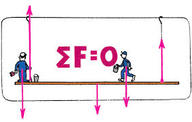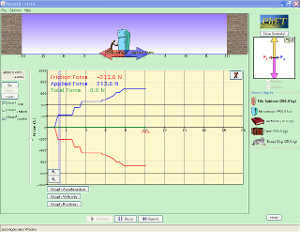Chapter 2: Mechanical Equilibrium
|
Pace: 5 days
|
Big Ideas |
Standards |
|
P3.1 Basic Forces in Nature
Objects can interact with each other by “direct contact” (pushes or pulls, friction) or at a distance (gravity, electromagnetism, nuclear). P3.2 Net Forces Forces have magnitude and direction.The net force on an object is the sum of all the forces acting on the object. Objects change their speed and/or direction only when a net force is applied. If the net force on an object is zero, there is no change in motion (Newton’s First Law). |
P3.1A Identify the force(s) acting between objects in “direct contact” or at a distance. P3.2A Identify the magnitude and direction of everyday forces (e.g., wind, tension in ropes, pushes and pulls, weight). P3.2B Compare work done in different situations. P3.2C Calculate the net force acting on an object. |
2 Pretest and Student DifferentiationIf you score a 90% or above on this pretest on your first attempt you will not need to complete any of the practice for this unit and an accelerated assignment will be provided. The pretest is not open internet or buddy or book. This pretest will be timed and may only be completed in class.
Student Examples:
no student tested out of this unit |
Ch 2 PDF textbook
| ||||||
DAY 1 - 19 Sept
|
DAY 1 PRACTICE
1. Video Notes
Watch the Video and complete cornell notes in your lab notebook with diagrams. Take the quiz at the end and record the results in your notebook as a review but you do not need to email it to me.
| ||||||||||||||||
DAY 2-3 - 23/24 Sept
|
Day 2-3 PRACTICE
1.
2.2 Video Notes Watch the Video and complete cornell notes in your lab notebook with diagrams. Take the quiz at the end and record the results in your notebook as a review but you do not need to email it to me.
3.
2.4 Video Notes Watch the Video and complete cornell notes in your lab notebook with diagrams. Take the quiz at the end and record the results in your notebook as a review but you do not need to email it to me. 4.
2.4 Book Notes Use the BOLD IDEAS in 2.4 to create Cornell Notes with diagrams to review the big ideas 2.4 PRACTICE Use the ch2.concept_development.pdf to practice in your notebook.
| ||||||||||||||||
Day 3 - 24 Sept
|
DAY 3 PRACTICE
|
|
2.
2.5 Book Notes Use the BOLD IDEAS in 2.5 to create Cornell Notes with diagrams to review the big ideas. 3. 2.5 Practice Complete the following online Vector and Scalars Practice. Record your work in your lab notebook. |
Terms:
Vector Tension Equilibrium Resultant Parallelogram Rule Newton (N) |
Day 4
| ||||||||||||||
| walking_the_plank_lab.pdf | |
| File Size: | 203 kb |
| File Type: | |
Forces PhET for EC
| phet_-_forces_1d_-_ohs_2013_version-2.doc | |
| File Size: | 60 kb |
| File Type: | doc |
Extra Credit This Weekend!
|
WHEN:
Friday and Saturday at Kensington MetroPark 6pm - Midnight COST: Free if you have a metro parks pass or $7 per car. WHERE: Kensington Metro Park (see map) WHAT DO I DO? Attend, participate and represent Huron High School with pride. Write a one-page reflection that includes photos of you working and learning on a topic of your choice at the event below. Share a completed Google Doc to [email protected] by 1 October. Thanks to Mr. Damron for letting us know about this event! |
Your browser does not support viewing this document. Click here to download the document.
|


